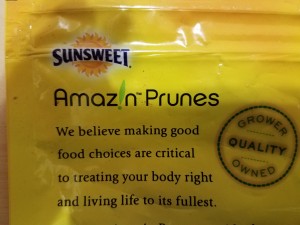Why you need a copy editor (a new series)
A few weeks ago I shared with you a picture of a postcard that advertised a townhouse for sale at more than $51 million. It was an error that would have been caught by a copy editor but likely not by a proofreader. That’s because a proofreader seeks and corrects mistakes such as typos, misspellings, extra words, repeated words, and other errors. A proofreader does not look at the content, and rarely queries the accuracy of amounts. A copy editor, on the other hand, goes beyond checking for mistakes, and also verifies that sentences are clear and accurate (e.g., the correct address, the right day of the week, the correct amount, etc.).
Sadly, there are many examples of printed materials that needed a copy editor, or at the very least, a proofreader, to check them, and did not get either. My goal is to find these examples and share them with you.
Today, I was looking at the back of a Sunsweet Prunes package:
Can you spot the mistake? Here’s a hint: it’s subject-verb agreement.
A grammatically correct sentence would read:
We believe making good food choices is critical to treating your body right and living life to its fullest.
Subject-verb (dis)agreement is a very common mistake. The subject should always match the verb, that is, a singular subject needs a singular verb, and a plural subject needs a plural verb. Lots of people have problems identifying the subject. In this case, the writer is not correctly identifying the subject, and is thrown off because he/she sees that a plural word (“choices”) goes right before the verb. In this sentence, the plural “choices” is not the subject, rather the singular phrase “making good food choices” is the subject.
I am a bit shocked that a large international company would make this type of mistake in its packaging. Perhaps it should hire a copy editor!
